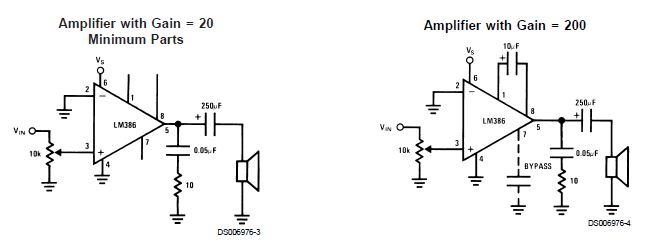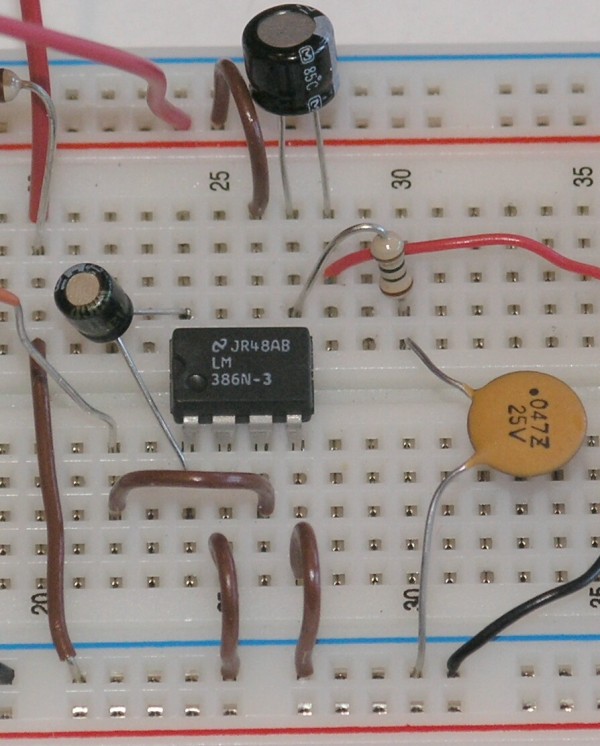The LM386 is an audio amplifier designed for use in low voltage consumer
applications. The gain is internally set to 20 to keep external part
count low, but the addition of an external resistor and capacitor
between pins 1 and 8 will increase the gain to any value from 20 to 200.
Parts will be assembled and connected according to the following schematic:
Parts will be assembled and connected according to the following schematic:

This project uses an integrated circuit with capacity of 10 transistors to amplify much better with much less power drain on the batteries than our simple amplifier.

Following parts are required:
- A LM386 integrated circuit amplifier chip
This is the main working part of the amplifier. - A small speaker
- Some jumper wires
- 9 volt DC adapter of 2 Amps or more or 9 volt battery clip and 9 volt battery
The Three Penny Radio normally has a piezoelectric earphone attached at points J-20 and E-22. We replace the earphone with our amplifier.
Below is a closeup of the amplifier section:

Here you can see that we have connected the Three Penny Radio output at J-20 to the ground rail below the blue line. This rail has all of its holes connected together. We connect the black (negative) wire from the battery to the ground rail. We connect the red (positive) wire from the battery to the power rail, just above the red line at the top of the photo. Having the power and ground connected to these rails makes it easier to connect the other parts, and makes it easier to see where all the connections are.
You can connect your audio source instead of radio.
The other output from the Three Penny Radio us plugged into E-22.
Using the labeled grid as before, the parts are connected this way:
- LM386 amplifier chip at E-24, E-25, E-26, E-27 and F-24, F-25, F-26, and F-27.
- Jumper wire: F-20 to ground rail.
- Jumper wire: C-22 to C-26.
- Jumper wire: A-25 to ground rail.
- Jumper wire: A-27 to ground rail.
- Jumper wire: J-26 to power rail.
- Speaker: red wire to H-27 and black wire to ground rail.
- Negative 9 volt battery wire (black): ground rail.
- Positive 9 volt battery wire (red): power rail.

This bypasses a resistor inside the integrated circuit, boosting the gain from 20 to 200.
One problem with the circuit so far is that the speaker will get warm and the battery will not last long. This is because a certain amount of DC current is going through the speaker. Direct current (DC) does not make sounds, and so this current is a complete waste of battery power, and simply warms up the speaker coil.

To prevent the capacitor from changing the sound, we add two more components to create a "filter" that lets only audio frequencies get to the speaker.

Our amplifier is working pretty well now. But our little speaker has a high tinny voice, because of its size. It would be nice if it had a little more power on the lower frequencies, what we call "bass response".
We can arrange to amplify the lower frequencies more than the high ones. We make another filter from a 0.033 microfarad capacitor and a 10,000 ohm resistor, and connect that between the output pin and pin 1 of the integrated circuit. This will feed some of the low frequencies back into the amplifier to be amplified again.
We put the 10,000 ohm resistor in holes C-24 and F-29. We put the 0.033 microfarad capacitor in holes I-27 and I-29.









0 comments:
Post a Comment